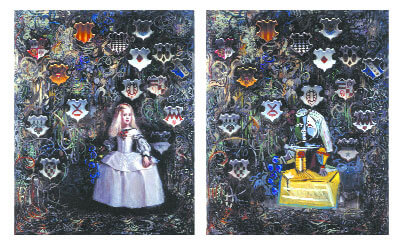Domingo Barreres’ provocative paintings are darkly complex, but devoid of irony
“Las Meninas, Earthly Delights and Other Investitures,” an exhibition of Domingo Barreres’ intensely envisioned paintings, is in its last ten days at White Box in Chelsea. Crafted with the visual texts of Velazquez and Bosch and the literary texts of Garcia Lorca and Wallace Stevens these paintings reveal the artist’s deep desire to look at the current state of humankind.
Spanish-born, Barreres, is a long-time Boston resident and a senior painting faculty member at its Museum School. He is well known there for his appetite for seduction and virtuosity, painterly and otherwise. This body of work, an apparent inspection of these affections, brings highly personal material to what might be the most politically conceived work of his career.
Barreres continues to dazzle the viewer with an old-master deftness for intense lighting and spatial illusions, technical tricks that speak of a deep reverence for the history of painting, and a hedonistic relationship with the stuff itself. Each canvas holds a range that moves from skilled draftsmanship to wonton gesture, revealing a maker so at ease with his craft as to not concern himself with issues of style or aesthetic positioning. With an emotional severity that is rarely seen, these paintings lurch toward the operatic, while being totally devoid of irony. This, together with artists’ complex textural assertions, might set the viewer on edge. However, it’s the blur of ideas, physicality, and emotion that elicit empathy with the painter, as we all try to order the world we share.
One painting might best reveal the sites of Barreres’ personal dialogue with institutionalized virtuosity. In “Investiture” he plays with reverberations of the word’s core meaning, virtue. Barerres casts himself, older and much heavier, as a scarlet-sashed cardinal of the Roman Catholic Church. An insignia affiliated with “the painter,” used in other canvases, is inscribed on the chest of his rich black cassock, conflating a reference to canons, both religious and art historical.
Here Barreres envisions himself as a powerful dignitary, with a kind but doleful gaze. Standing firm, perhaps as a standard for cardinal virtues, he is a mass enshrined by a sea of tiny falling buds that are like purple flames. With this provocative image, splendidly painting a deep identification with Catholicism in the midst of scandalous times, the artist ushers into us into a dark complexity of issues that may never be illuminated by paint alone.



































